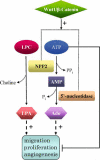Modulation of purinergic signaling by NPP-type ectophosphodiesterases
- PMID: 18404476
- PMCID: PMC2254485
- DOI: 10.1007/s11302-005-5303-4
Modulation of purinergic signaling by NPP-type ectophosphodiesterases
Abstract
Extracellular nucleotides can elicit a wide array of cellular responses by binding to specific purinergic receptors. The level of ectonucleotides is dynamically controlled by their release from cells, synthesis by ectonucleoside diphosphokinases and ectoadenylate kinases, and hydrolysis by ectonucleotidases. One of the four structurally unrelated families of ectonucleotidases is represented by the NPP-type ectophosphodiesterases. Three of the seven members of the NPP family, namely NPP1-3, are known to hydrolyze nucleotides. The enzymatic action of NPP1-3 (in)directly results in the termination of nucleotide signaling, the salvage of nucleotides and/or the generation of new messengers like ADP, adenosine or pyrophosphate. NPP2 is unique in that it hydrolyzes both nucleotides and lysophospholipids and, thereby, generates products that could synergistically promote cell motility. We review here the enzymatic properties of NPPs and analyze current evidence that links their nucleotide-hydrolyzing capability to epithelial and neural functions, the immune response and cell motility.
Figures





Similar articles
-
NPP-type ectophosphodiesterases: unity in diversity.Trends Biochem Sci. 2005 Oct;30(10):542-50. doi: 10.1016/j.tibs.2005.08.005. Trends Biochem Sci. 2005. PMID: 16125936 Review.
-
Physiologic and pathologic functions of the NPP nucleotide pyrophosphatase/phosphodiesterase family focusing on NPP1 in calcification.Purinergic Signal. 2006 Jun;2(2):371-7. doi: 10.1007/s11302-005-5304-3. Epub 2006 Jun 1. Purinergic Signal. 2006. PMID: 18404477 Free PMC article.
-
Diadenosine 5',5''-(boranated)polyphosphonate analogues as selective nucleotide pyrophosphatase/phosphodiesterase inhibitors.J Med Chem. 2010 Dec 23;53(24):8485-97. doi: 10.1021/jm100597c. Epub 2010 Nov 22. J Med Chem. 2010. PMID: 21090681
-
Activity and expression of ecto-nucleotide pyrophosphate/phosphodiesterases in a hepatic stellate cell line.Mol Cell Biochem. 2009 May;325(1-2):179-85. doi: 10.1007/s11010-009-0032-6. Epub 2009 Feb 5. Mol Cell Biochem. 2009. PMID: 19194664
-
How to influence the mesenchymal stem cells fate? Emerging role of ectoenzymes metabolizing nucleotides.J Cell Physiol. 2018 Jan;234(1):320-334. doi: 10.1002/jcp.26904. Epub 2018 Aug 4. J Cell Physiol. 2018. PMID: 30078187 Review.
Cited by
-
Structural and functional characterization of engineered bifunctional fusion proteins of CD39 and CD73 ectonucleotidases.Am J Physiol Cell Physiol. 2021 Jan 1;320(1):C15-C29. doi: 10.1152/ajpcell.00430.2020. Epub 2020 Oct 14. Am J Physiol Cell Physiol. 2021. PMID: 33052071 Free PMC article.
-
Role of ENPP1 in cancer pathogenesis: Mechanisms and clinical implications (Review).Oncol Lett. 2024 Oct 3;28(6):590. doi: 10.3892/ol.2024.14722. eCollection 2024 Dec. Oncol Lett. 2024. PMID: 39411204 Free PMC article. Review.
-
Design and Development of Autotaxin Inhibitors.Pharmaceuticals (Basel). 2021 Nov 22;14(11):1203. doi: 10.3390/ph14111203. Pharmaceuticals (Basel). 2021. PMID: 34832985 Free PMC article. Review.
-
Free amino acids accelerate the time-dependent inactivation of rat liver nucleotide pyrophosphatase/phosphodiesterase Enpp3 elicited by EDTA.Amino Acids. 2024 Dec 6;57(1):1. doi: 10.1007/s00726-024-03431-4. Amino Acids. 2024. PMID: 39641818 Free PMC article.
-
Discovery of VH domains that allosterically inhibit ENPP1.Nat Chem Biol. 2024 Jan;20(1):30-41. doi: 10.1038/s41589-023-01368-5. Epub 2023 Jul 3. Nat Chem Biol. 2024. PMID: 37400538 Free PMC article.
References
-
- {'text': '', 'ref_index': 1, 'ids': [{'type': 'DOI', 'value': '10.1055/s-2005-869519', 'is_inner': False, 'url': 'https://doi.org/10.1055/s-2005-869519'}, {'type': 'PubMed', 'value': '15852217', 'is_inner': True, 'url': 'https://pubmed.ncbi.nlm.nih.gov/15852217/'}]}
- Boeynaems JM, Communi D, Gonzalez NS, Robaye B. Overview of the P2 receptors. Semin Thromb Hemost 2005; 31: 139–49. - PubMed
-
- {'text': '', 'ref_index': 1, 'ids': [{'type': 'DOI', 'value': '10.1161/hq0302.105360', 'is_inner': False, 'url': 'https://doi.org/10.1161/hq0302.105360'}, {'type': 'PubMed', 'value': '11884276', 'is_inner': True, 'url': 'https://pubmed.ncbi.nlm.nih.gov/11884276/'}]}
- Burnstock G. Purinergic signaling and vascular cell proliferation and death. Arterioscler Thromb Vasc Biol 2002; 22: 364–73. - PubMed
-
- {'text': '', 'ref_index': 1, 'ids': [{'type': 'DOI', 'value': '10.1007/s102380200006', 'is_inner': False, 'url': 'https://doi.org/10.1007/s102380200006'}, {'type': 'PMC', 'value': 'PMC4953172', 'is_inner': False, 'url': 'https://pmc.ncbi.nlm.nih.gov/articles/PMC4953172/'}, {'type': 'PubMed', 'value': '11871639', 'is_inner': True, 'url': 'https://pubmed.ncbi.nlm.nih.gov/11871639/'}]}
- Burnstock G. Potential therapeutic targets in the rapidly expanding field of purinergic signaling. Clin Med 2002; 2: 45–53. - PMC - PubMed
-
- {'text': '', 'ref_index': 1, 'ids': [{'type': 'DOI', 'value': '10.1189/jlb.1102561', 'is_inner': False, 'url': 'https://doi.org/10.1189/jlb.1102561'}, {'type': 'PubMed', 'value': '12660218', 'is_inner': True, 'url': 'https://pubmed.ncbi.nlm.nih.gov/12660218/'}]}
- Sak K, Boeynaems JM, Everaus H. Involvement of P2Y receptors in the differentiation of haematopoietic cells. J Leukoc Biol 2003; 73: 442–7. - PubMed
-
- {'text': '', 'ref_index': 1, 'ids': [{'type': 'DOI', 'value': '10.1016/j.brainresrev.2004.12.005', 'is_inner': False, 'url': 'https://doi.org/10.1016/j.brainresrev.2004.12.005'}, {'type': 'PubMed', 'value': '15850654', 'is_inner': True, 'url': 'https://pubmed.ncbi.nlm.nih.gov/15850654/'}]}
- Agresti C, Meomartini ME, Amadio S et al. ATP regulates oligodendrocyte progenitor migration, proliferation, and differentiation: Involvement of metabotropic P2 receptors. Brain Res Rev 2005; 48: 157–65. - PubMed
LinkOut - more resources
Full Text Sources
Other Literature Sources
Miscellaneous

